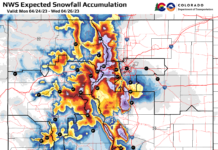heavy snowfall may be contributing to increased roadkill
by Anastasia Button
Grand County residents, driving on Hwy 40 between Granby and Kremmling, may have noticed a few (dozen) deer and elk along the way. Locals have been making heavy comments about the amount of wildlife along the roadsides of Highway 40 to be more than usual at this time of the year.
Bryan Lamont, Terrestrial Biologist with the Parks and Wildlife-Hot Sulphur Springs, sheds light as to why Grand County residents may be seeing more wildlife and roadkill this year. “The majority of deer and elk in Middle Park are migratory, spending their summers at higher elevations looking for highly nutritious forage, and then moving to lower elevation winter ranges once the snow loads become too deep to find food. As the snow gets deeper and deeper these animals continue to be constrained closer to the valley floors, which happens to be where our roadways also exist. As a result, when we have big snows like we had at the beginning of February, you are likely to see more deer, elk and pronghorn near the roads,” says Lamont.
When there are enough breaks between storms it allows animals to access food easier. But this year, during early February there were less breaks between storms and we received a significant accumulation of snow in a short period of time.
“When you get a big snowstorm and the next day it is sunny it results in ice crusting over the snow. When those conditions stay consistent along with negative temperatures for multiple days or more it creates a situation for the animals where they cannot paw through the snow to reach the food they need to survive” Lamont explains.
Even though deer and elk are at a point in the season where they are nutritionally stressed and are moving to the sides of roadways into these critical winter range areas, “somewhat surprisingly many of the deer and elk continue to be in moderately good body condition for this time of year. Having said that, it is important to remember that these animals have to endure hard winters and whatever the public can do to minimize additional stress on these animals is critical,” says Lamont.
Every year Parks and Wildlife monitor 240 radio-collared deer in the area which include 90 bucks, 90 does, and 60 fawns. Tracking the survival and causes of mortality of these animals provides the agency with an understanding of how well these animals are doing throughout the year. Thus far, buck survival is 87%, does 96% and 79% for fawns.
Driving with continued caution and at reduced speeds is suggested throughout Grand County, not
only for your own safety, but to enable the deer and elk to survive through this hard time of the year.









